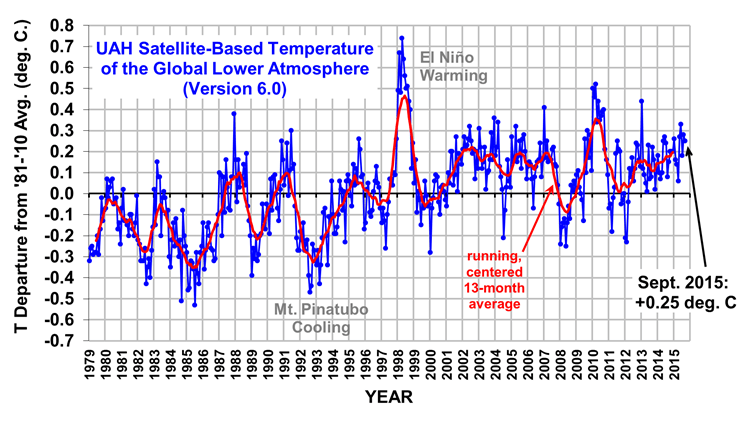NOTE: This is the sixth monthly update with our new Version 6.0 dataset. Differences versus the old Version 5.6 dataset are discussed here.
The Version 6.0 global average lower tropospheric temperature (LT) anomaly for September, 2015 is +0.25 deg. C, down slightly from the August, 2015 value of +0.28 deg. C (click for full size version):
The global, hemispheric, and tropical LT anomalies from the 30-year (1981-2010) average for the last 9 months are:
YR MO GLOBE NH SH TROPICS
2015 1 +0.28 +0.40 +0.16 +0.13
2015 2 +0.18 +0.30 +0.05 -0.06
2015 3 +0.17 +0.26 +0.07 +0.05
2015 4 +0.09 +0.18 -0.01 +0.10
2015 5 +0.29 +0.36 +0.21 +0.28
2015 6 +0.33 +0.41 +0.25 +0.46
2015 7 +0.18 +0.33 +0.03 +0.48
2015 8 +0.28 +0.25 +0.30 +0.52
2015 9 +0.25 +0.14 +0.17 +0.55
The tropics continue to slowly warm with El Nino conditions there.
The global image for September, 2015 should be available in the next several days here.
The new Version 6 files (use the ones labeled “beta3”) should be updated soon, and are located here:
Lower Troposphere: http://vortex.nsstc.uah.edu/data/msu/v6.0beta/tlt
Mid-Troposphere: http://vortex.nsstc.uah.edu/data/msu/v6.0beta/tmt
Tropopause: http://vortex.nsstc.uah.edu/data/msu/v6.0beta/ttp
Lower Stratosphere: http://vortex.nsstc.uah.edu/data/msu/v6.0beta/tls

 Home/Blog
Home/Blog




